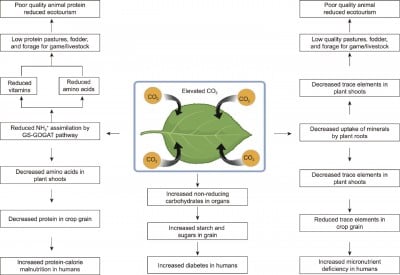Cooking Up Change: The Flavorful Dilemma of Elevated CO2 and Our Food Future
As we gather around our dinner tables, little do we know there’s a bubbling pot of change simmering beneath our crops — and it’s all thanks to rising levels of carbon dioxide (CO2). A recent study from Engineering reveals a fascinating, yet worrying, intersection of climate change and food security that is set to redefine our ingredients and plates for years to come.
The Upside: A Boost for Some Greens
Imagine walking through a lush garden filled with thriving C3 plants — think delightful wheat, vibrant beans, and leafy greens — all popping with the energy of increased photosynthesis thanks to heightened CO2 levels. There’s a silver lining here! In these plants, the rise in CO2 can lead to:
- Increased Yield: More dry matter means more grain at harvest time.
- Nutrient Fixation: Legumes enjoy a nitrogen boost that reduces our reliance on chemical fertilizers. Mother Nature giving us a nudge in sustainability? Yes, please!
- Water-Sippers: These plants become water-efficient, quenching their thirst less often — a win in drought-prone areas.
However, our food journey soon takes a detour…
The Dark Side: Nutrient Nosedive and the Quality Quandary
As we dive deeper, things start to sour. While green growth may flourish, essential nutrients found in our crops are taking a hit:
- Protein Loss: Wheat grain protein drops by 7.4% — that’s a big loss for our beloved baked goods!
- Amino Acid Decline: Vital components for our health are diminishing in various plant organs.
- Mineral Misery: Key minerals like phosphorus, iron, and zinc play hide and seek — decreased levels in staples like rice and maize could spell disaster, particularly for regions relying on these for nourishment.
Imagine your hearty rice dish gradually losing its zest and nutritional punch. This is not just a future problem; it has the potential to double cases of protein-calorie malnutrition and micronutrient deficiencies, especially in nutrient-poor regions like Africa.
Culinary Solutions: How to Stir the Pot of Change
But don’t despair! The study hints at culinary creativity as a remedy to this unfolding crisis. Here are a few strategies worth noting:
- Farmers Unite: Cultivating crop varieties rich in biofortification traits can help restore lost nutrients.
- Trees on the Menu: Planting nitrogen-fixing trees not only captures CO2 but also enhances soil nutrients.
- Pulse Power: Switching to a more plant-based, pulse-heavy diet can benefit our health and reduce methane emissions from livestock.
The Road Ahead: Cooking Up Research
The culinary cosmos needs our attention! Researchers call for an exploration into how C3 plants react under these new atmospheric chefs at work. A dash of artificial intelligence in breeding might whip up crop varieties that are resilient to climate change and packed with nutritional goodness.
As we prepare our meals, remember that every bite connects us to a larger narrative of health, sustainability, and change. Let’s keep our eyes peeled for the tasty twists that climate may bring, and make the most of every delicious, nutrient-packed morsel that graces our plates! 🌱✨

Covers wellness, nutrition, mental health, and daily life tips.
Bio: Talia brings a background in health journalism and holistic living to help readers live better, one tip at a time.

